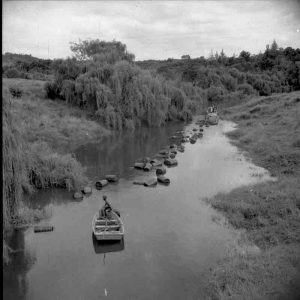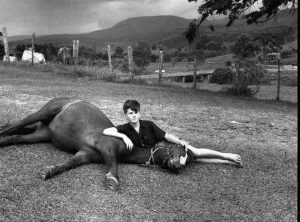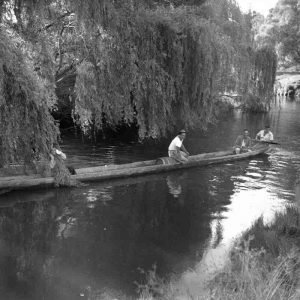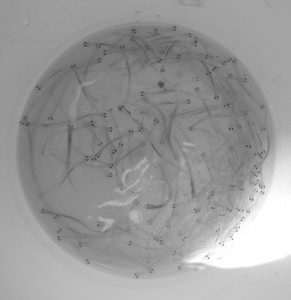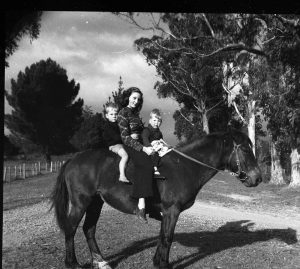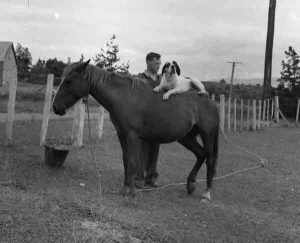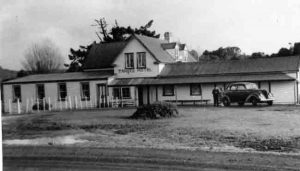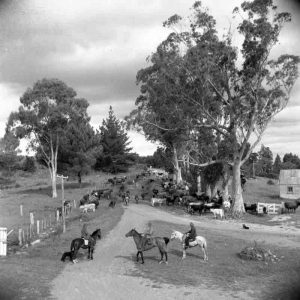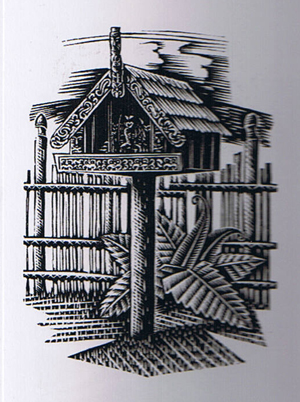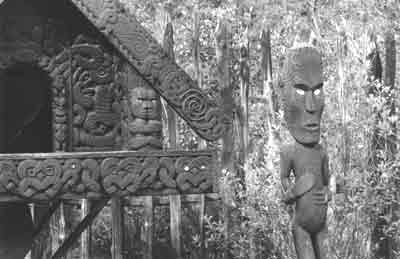Taheke River
My Father the Boxer
Fights usually took place out on the grass in front of the hotel. The fights I remember were the ones involving my father. He would take out his top denture, put it on a shelf behind the bar for safe keeping, and then step outside to take part in a fist fight. I never saw him show fear and I never saw him defeated. He had fast hands and knew how to deliver a punch. It’s a complex science, involving balance, speed and timing.

I don’t know how often but he ran a boxing gym for local Maori. The gym was in the building
in the top left of this photo. Sadly, it has now gone.
My brother is on the left of the horse, hanging out with a friend. What the horse is thinking I’m not sure.
The gravel road just behind the horse is not someone’s driveway but the main road north. At this time Taheke was about 5 and a half hours north of Auckland, now it is 3 and a half.
I was always impressed by the gym and was encouraged to learn about boxing. I believe that even the limited experience I had of it taught me something. In boxing there is an emphasis on stoicism, even if you’re on the ropes and someone is thumping your head with their fists and you have a funny metallic taste in your mouth you have to keep thinking or else you’re toast. You have to hang in there waiting for the opportunity to strike back. Even though this sort of stoicism is not talked about much now, increasingly I feel that there’s something to be said for the quality.
More Family

Standing outside the Taheke Hotel, here I am with my mother, my father’s father, and my sister. I’m the slightly disturbed looking one in the front, the short one.
Pater, as I had to call my grandfather, was someone I saw on very few occasions in my life. I only have a couple of images of him in my mind. He died not very many years after this photo was taken, in Gisborne, at the age of 88.
I have impressions though. He was dressed in a fashion I was not exposed to much. I don’t remember him in anything else except a three piece suit. I remember how he was different, he was English, having emigrated here as a young man.
He was very strict and formal. Even the name, Pater, was formal. Strangest of all perhaps was that he liked to write poetry. Believe me, to meet a man who was proud of writing poetry was something of a mind bender for someone liked me who was being schooled in the cultural mores of the time. How a proper male should behave was clearly proscribed and strictly enforced. Homosexuals went to gaol.
Something else about him impressed me. He had an air of being somewhat educated. Apart from the priests, teachers, doctors, I didn’t know anyone like this. If fact I have no idea what his education was like, or if his poetry was worthy, none is extant.
Somehow he influenced me though. I’m not sure how, perhaps he opened a window on a different world.
Bryan
This is my brother Bryan. It appears that our family mainly used horses as furniture but I assure you this wasn’t the case.
This photo has some clues in it. The concrete bridge in the background spans the Taheke River, like an invading army it allowed roads to take over from the centuries old river transport that had prevailed.
On the other side of the river was Waima, a Maori community, you can see two or three houses in the photo. Beyond the right of this photo was their marae, and I don’t know whether it was my imagination or not but I remember a couple of occasions when there was a tangi and I could hear women wailing, their voices carrying across the valley and the river.
Two of the Maori surnames that I remember from Waima were Panaho and Pehi. Here are 4 locals on a horse, a horse that still feels like eating fortunately. The river is in the background. Notice the mud on its legs.
 I meant to tell you that sometimes I would see large mullet in the river, swimming over the shingly bottom.
I meant to tell you that sometimes I would see large mullet in the river, swimming over the shingly bottom.
The river was clear. Black fresh water mussels stuck out of the shingly bottom. Mysterious to me was being told that some Maori women at the time of giving birth would squat into ankle deep water and utilise the cleansing waters of the current. I hope that this is true because it’s an attractive idea.
Taheke River
Yet it had been for all human settlers, for centuries, a major highway. Roads, including bridges changed it’s significance within a few decades. The town of Taheke all but died. There was a two room school, a shop, the pub, a few private houses. There was however, in the surrounding hinterland a large population of Maori.
Here are four of them, they’ve been to my parent’s pub and are heading home, carrying on board a keg of beer. (Click on photo to enlarge).
The waka in this photo has been preserved now, on display in one of the Hokianga towns, Opononi, or Rawene I think it is. I’ve only recently found out about this and I’m overdue for a Hokianga trip so I haven’t seen it with my own eyes but I believe it to be true.
The character on the left is enjoying those wonderful slender willow tendrils. I still want to photograph them, especially trailing in the water when it is in flood. I’ve pursued the same look in seaweed, the way the swell moves it around and the leaves constantly rearrange themselves into positions that you just know will be mathematically perfect every time. It’s the sort of thing that gives me a thrill.
There was an abundance of whitebait in the river, 4 gallon tins with number 8 wire handles, filled to maximum. As the whitebait season is just opening now I thought that I would include a whitebait photograph that I took a couple of years ago. I went whitebaiting with a friend in Southland and when I saw these in the bottom of a bucket with the sun shining in, I put this picture together. I seem to like those triangles of light coming in from the side.
I liked a friend’s description “ the circle of life”.
Three Horses
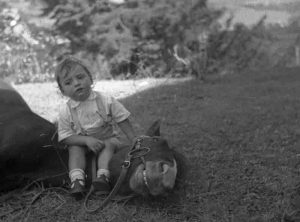
I’m continuing the story of my father and his horses, and our time when my parents
ran the Taheke Hotel in the Hokianga.
The first photo is a mystery in that we don’t know the name of the child, but it does demonstrate how my father enjoyed working with horses. He would know that the horse would hold still while the child sat on its neck. I find it very interesting as a photograph, the composition is arresting for a start, quite apart from the unusual view of a horse’s head. The white triangle that comes in from the left is strong too. I doubt if my father ever knew how good this photo was.
The last photo is another of Natalie, this time in the bar of the hotel. The smell of horse was a big part of my childhood and lo and behold I think that I can smell horses right now. It’s warm and spicy.
Taheke, Hokianga
In the Far North, Taheke Hotel was where my family lived in the late 40’s. In the gumfields nearby there were wild horses. Maori would round them up and sell them and my father purchased some. One was called Five Bob because that’s how much my father paid for it. He would tame the horses, many of them becoming extremely docile.
I don’t know the name of this horse but I remember that the dog was called Whisky. I remember the day he died, his tongue was so pale it was almost white, and it lolled out of his mouth.
to the abattoir or as we euphemistically called it, the freezing works. The age of cattle drives is over, roads are too busy. Now cattle are trucked.
The drovers would often stop and have a beer and let their dogs and the cattle have a rest, and I remember being given an old stock whip by one of them which I kept for a long time. My father would do tricks with a stock whip so I was not discouraged from playing around with one myself. I can still use one with a certain amount of dexterity but I don’t own one anymore
However it was knife throwing that I was best at. In fact I still have the knack of making a knife hit a target sharp end first and I practise whenever I can. Nothing is safe around this place.
 Four Photos From the Past
Four Photos From the Past
Here are four photos from my early childhood. My parents ran the Taheke Hotel
in the Hokianga, in the far north of New Zealand. Milton, my father was interested
in training horses most of which had been wild ones that roamed some of the old gumfields nearby.
The Maori in the canoe were going home with a barrel of beer bought at the hotel.
Some communities were not accessible by road, and this canoe was a kind of taxi. This particular canoe has been saved. It is now on display at Rawene.
The cattle were being driven to the freezing works, it was a time before trucks were used for large herds. Stockwhips and dogs were used to keep them moving. One of the highlights of my life at that time was being given a stockwhip by one of the drovers. I became quite adept at using it and still am.
In the entry below I’ve discussed how these wood engravings attracted my attention when I was at Primary School in Taheke, and later, in Ohaeawai in the Bay of Islands, in the Far North of New Zealand.
Published in NZ School Journals, who are about to celebrate their one hundreth anniversary, these pictures impressed me. The subject matter was so familiar, and the images charming.
This photo I took at Whakarewarewa, in Rotorua, in 1993. About 3 hours south of Auckland I had been there several times looking for this image. At the time I was particularly short of money, so a friend, Trevor Haysom, gave me the funds for the trip. Whakarewarewa is a site epecially built for tourists.

